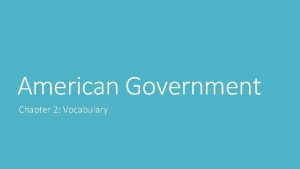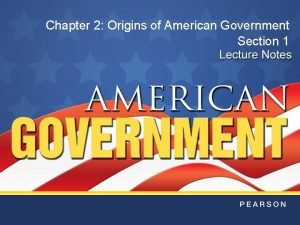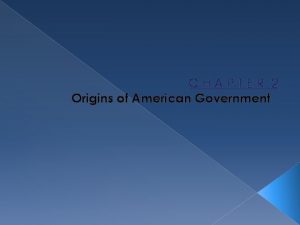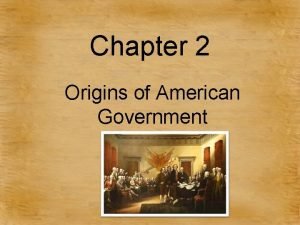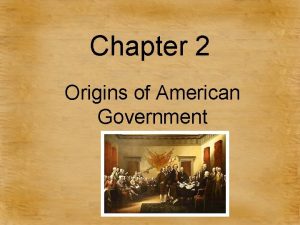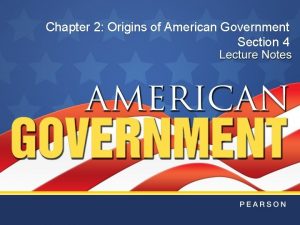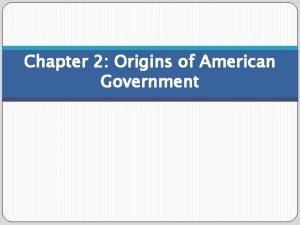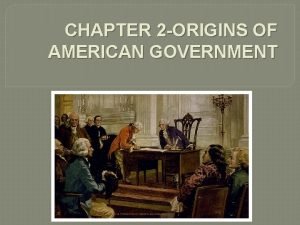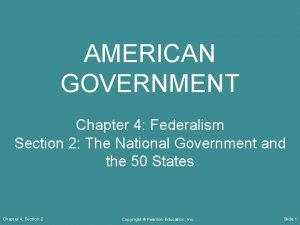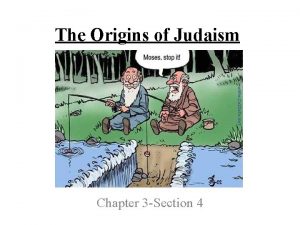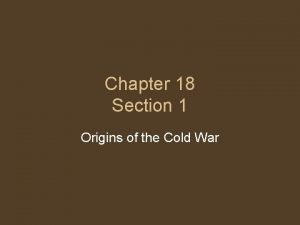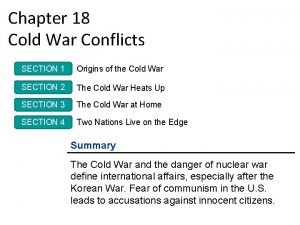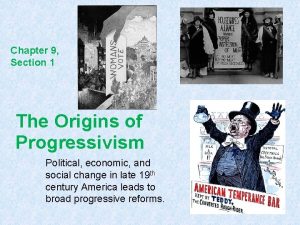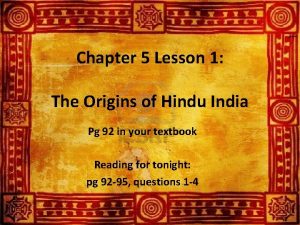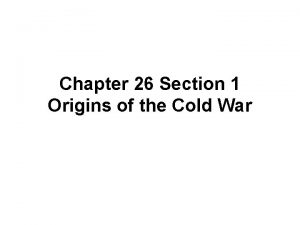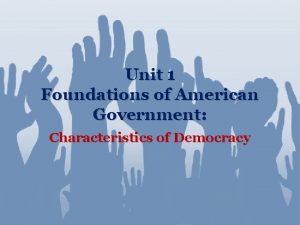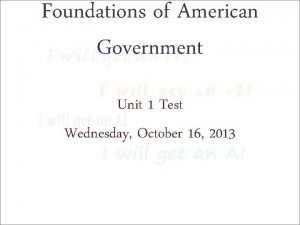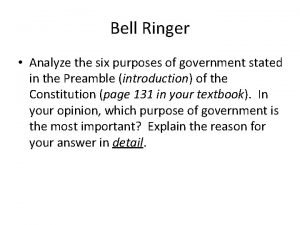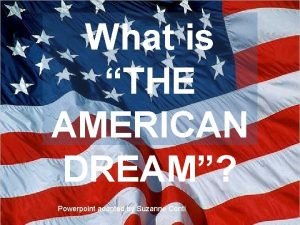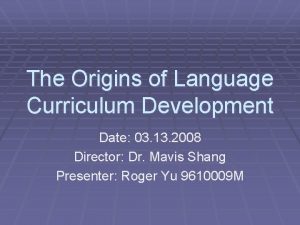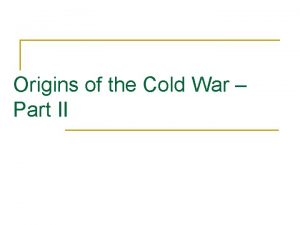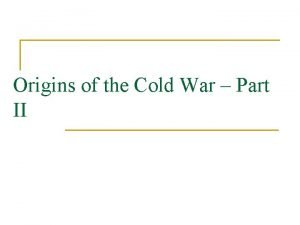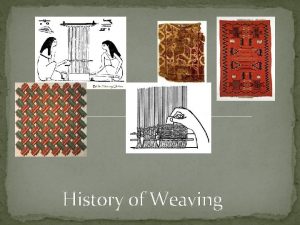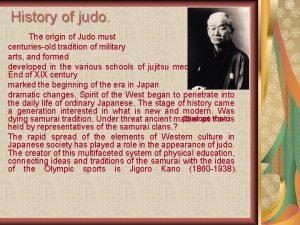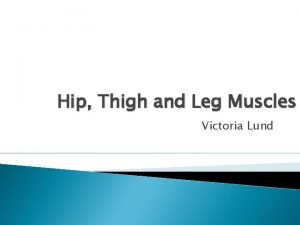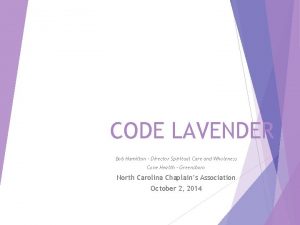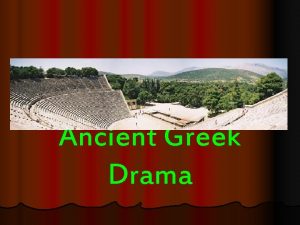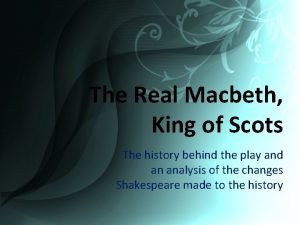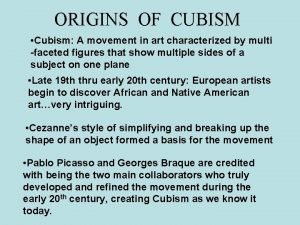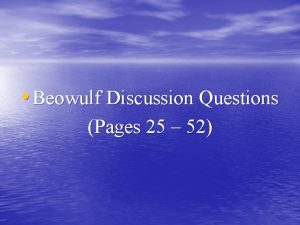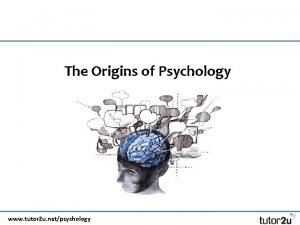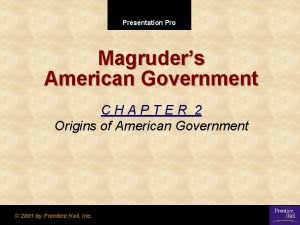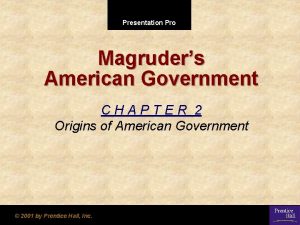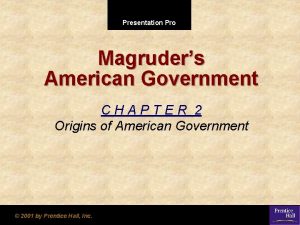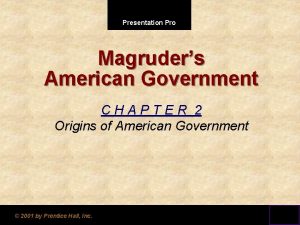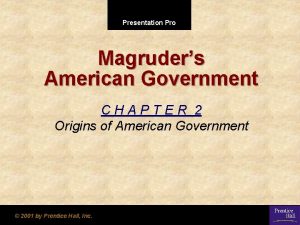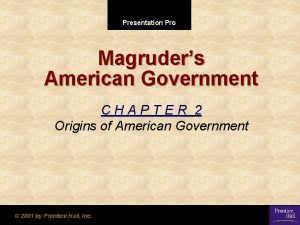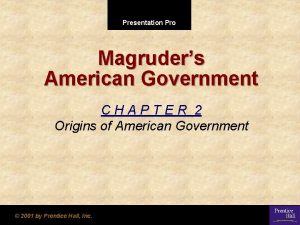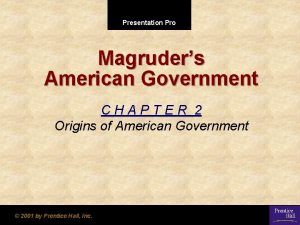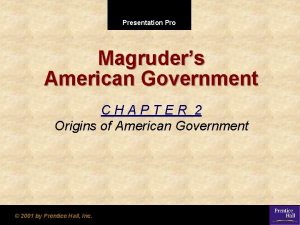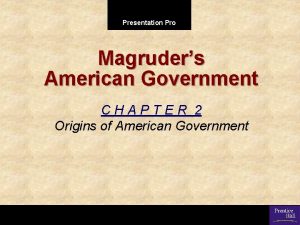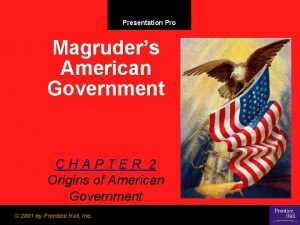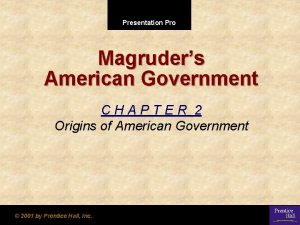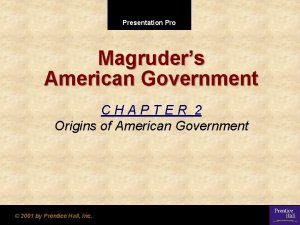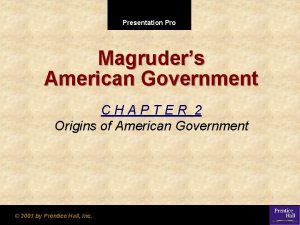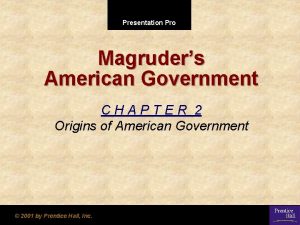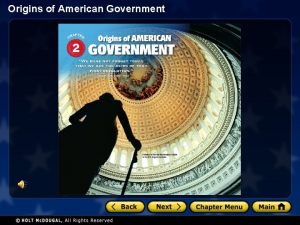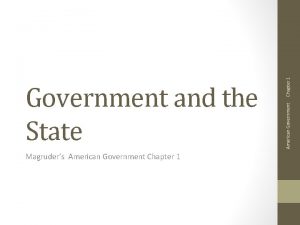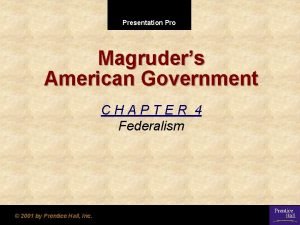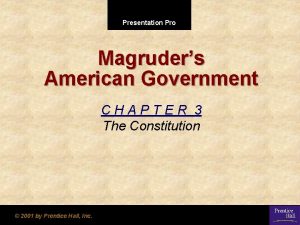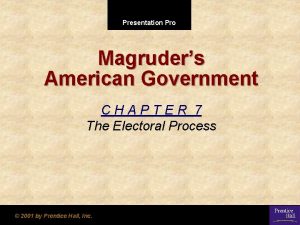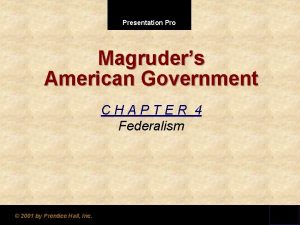Presentation Pro Magruders American Government CHAPTER 2 Origins


































![Declaration of Independence • Writers: Thomas Jefferson [main author], John Adams, Benjamin Franklin, Roger Declaration of Independence • Writers: Thomas Jefferson [main author], John Adams, Benjamin Franklin, Roger](https://slidetodoc.com/presentation_image_h2/82452b81069e3af1ccf502686403f973/image-35.jpg)














![Meet the Framers! • 12/13 states sent delegates [all except Rhode Island] • Out Meet the Framers! • 12/13 states sent delegates [all except Rhode Island] • Out](https://slidetodoc.com/presentation_image_h2/82452b81069e3af1ccf502686403f973/image-50.jpg)











- Slides: 61

Presentation Pro Magruder’s American Government CHAPTER 2 Origins of American Government © 2001 by Prentice Hall, Inc.

CHAPTER 2 Origins of American Government Go To Section: SECTION 1 Our Political Beginnings SECTION 2 The Coming of Independence SECTION 3 The Critical Period SECTION 4 Creating the Constitution SECTION 5 Ratifying the Constitution 1 2 3 4 5 Chapter 2

Bell Work: • Name some basic human rights and freedoms. • Where did you get your ideas about what your rights and freedoms are? Go To Section: 1 2 3 4 5

Today we are going to talk about where Colonial Americans got their ideas about people’s political rights and freedoms. Go To Section: 1 2 3 4 5

SECTION 1 Our Political Beginnings • What basic concepts of government were held by American colonists? • Which important English documents have had the most influence on our government? • How were the governments of the thirteen colonies organized? Go To Section: 1 2 3 4 5 Chapter 2, Section 1

Basic Concepts of of Government The English colonists in America brought with them three main concepts: • The need for an ordered social system, or government. • The idea of limited government, that is, that government should not be all-powerful. • The concept of representative government—a government that serves the will of the people. Go To Section: 1 2 3 4 5 Chapter 2, Section 1

Ordered Government: • English colonists saw the need for an orderly regulation of their relationships with one another – for government. • They created local governments based on those they had known in England. • Many of the offices that they established are still with us today: sheriff, coroner, assessor, justice of the peace, grand jury, counties, townships, and others. Go To Section: 1 2 3 4 5

Limited Government: • Colonists brought with them the idea that government is not all-powerful, that it is restricted in what it may do, and each individual has certain rights that cannot be taken away or limited government. Go To Section: 1 2 3 4 5

Representative Government: • The idea that government should serve the will of the people. • The people should have a voice in deciding what government should and should not do. • “Government of, by, and for the people. ” Go To Section: 1 2 3 4 5

Important English Documents 1. The Magna Carta or “The Great Charter” • Signed in Runnymede in 1215—to restrain King John – Trial by jury – Due process of law » Protection against arbitrary taking of life, liberty, or property. – First intended only for the privileged classes. – Established the principle that the power of the monarch is NOT “absolute. ” Go To Section: 1 2 3 4 5

For the next 400 years, the Magna Carta was respected by some and ignored by others. Over time, England’s Parliament slowly grew in influence. In 1628 when Charles I asked for more money in taxes, Parliament refused until the Petition of Right was signed by Charles I. The Petition challenged the idea of the divine right of kings, declaring that even a monarch must obey the law of the land. Go To Section: 1 2 3 4 5

2. The Petition of Right— 1628, to limit the power of King Charles I when he asked Parliament for more taxes. • Limited the power of the king • Could not imprison or punish without judgment of peers or law of the land. • Could not impose martial law or military rule • Cannot require housing of the king’s troops in homes. Go To Section: 1 2 3 4 5

1688 • William and Mary of Orange were offered the crown. • Their events leading to the thrown are known as the Glorious Revolution. • To prevent abuse of power by William and Mary and future Monarchs, a list of provisions called the English Bill or rights were drawn up. Go To Section: 1 2 3 4 5

3. The English Bill of Rights— 1688 • Prohibited a standing army in peacetime. • That parliamentary elections be free. • That taxation without the approval of Parliament was prohibited. • Guaranteed right to a fair trial, freedom from excessive bail, and no cruel and inhuman punishment. Go To Section: 1 2 3 4 5

The Thirteen Colonies There were three types of colonies in North America: royal, proprietary, and charter. • Let’s Find them on the Map! Page 33 • The royal colonies were ruled directly by the English monarchy. • The King granted land to people in North America, who then formed proprietary colonies. • The charter colonies were mostly self-governed, and their charters were granted to the colonists. Go To Section: 1 2 3 4 5 Chapter 2, Section 1

Go To Section: 1 2 3 4 5

The English Colonies • The 13 colonies were established separately over a span of 125 years. • Trading posts and farm settlements developed into communities. • Virginia was the first colony founded in 1607 at Jamestown. • Georgia was the last settlement formed in Savannah in 1733. • Each colony was born out of a particular set of circumstances and each had its own character. Go To Section: 1 2 3 4 5

Section 1 Review 1. All of the following are basic concepts of government brought to the colonies by English settlers EXCEPT (a) the need for limited government. (b) the need for a representative government. (c) the need for an autocratic government. (d) the need for an ordered social system. 2. Which of the following was not one of the rights granted in the Magna Carta? (a) The right to private property. (b) The right to a trial by jury. (c) The right to freedom of religion. (d) The right to undergo due process of the law. Want to connect to the Magruder’s link for this chapter? Click Here! Go To Section: 1 2 3 4 5 Chapter 2, Section 1

Assignment: • Reading portions of the Magna Carta on Page 33, answer the following: • 1. Identify reasons why people would want to limit the power of their ruler or government. • • 2. How would you go about limiting this power? • 4. Write a short magazine article about the Magna Carta answering the question: Is this document the most important in the history of English and American Government? Why or Why not? 3. For each article (number) of the Magna Carta, identify the practice(s) it was intended to stop. Go To Section: 1 2 3 4 5

SECTION 2 The Coming of Independence • What were Britain’s colonial policies and how did the colonists react to them? • What were the outcomes of the First and Second Continental Congresses? • How did American independence come about, and what were its effects? Go To Section: 1 2 3 4 5 Chapter 2, Section 2

British Colonial Policies • Until the mid-1700 s, the colonies were allowed a great deal of freedom in their governments by the English monarchy. • In 1760, King George III imposed new taxes and laws on the colonists. • The colonists started a confederation, proposed an annual congress, and began to rebel. Go To Section: 1 2 3 4 5 Chapter 2, Section 2

Growing Colonial Unity Early Attempts • In 1643, several New England settlements formed the New England Confederation which was in defense against Native Americans • A confederation is a joining of several groups for a common purpose. Go To Section: The Albany Plan • In 1754, Benjamin Franklin proposed the Albany Plan of Union, in which an annual congress of delegates (representatives) from each of the 13 colonies would be formed- turned down by the colonies and crown 1 2 3 4 5 Chapter 2, Section 2

The Stamp Act Congress • 1765: England passes the Stamp Act which required the use of tax stamps on all legal documents, certain business agreements, and newspapers …colonists thought the prices were too high • In 1765, a group of colonies sent delegates to the Stamp Act Congress in New York. • These delegates prepared the Declaration of Rights and Grievances against British policies and sent it to the king. • Parliament repealed, or cancelled the Stamp Act…but passed other taxes • Colonists began to boycott all British goods • Boston Massacre • Committees of Correspondence led by Samuel Adams organized resistance (1772). • December 16, 1773—Boston Tea Party Go To Section: 1 2 3 4 5


• The First Continental Congress Parliament passed more laws to “punish” the colonies in 1774 • Intolerable Acts

Met on September 5, 1774 in Philadelphia • For 2 months • Issued a Declaration of Rights-a protest • Adjourned on October 26 calling for a second meeting. Go To Section: 1 2 3 4 5

Go To Section: 1 2 3 4 5

• The Second Continental Congress May 10, 1775, in Philadelphia • Battles of Lexington and Concord—”the Shot Heard Round the World”—April 19 Representatives from all 13 colonies—John Hancock as president. Our First National Government • From July 1776 -March 1, 1781

Go To Section: 1 2 3 4 5

Propaganda • A form of persuasion that appeals to emotions in order to convince people about the truth of a particular idea or point of view • Examples: • Advertisements • Editorials • Political speeches/writing • Testimonials Go To Section: 1 2 3 4 5

Propaganda- Political Cartoons • Use visual humor and exaggeration to persuade Bostonians Pay the Excise Man Go To Section: 1 2 3 4 5

Lord William Pitt as “The Colossus” Go To Section: 1 2 3 4 5

American Independence • A year after revolution began, they made a committee of five to prepare a proclamation of independence…but mostly written by Thomas Jefferson • On July 4, 1776, the Second Continental Congress adopted the Declaration of Independence. Go To Section: 1 2 3 4 5 Chapter 2, Section 2

• Uniqueness of document: v. No government based on ideas that people should rule, not be ruled v. Idea that every person is created equal v. Every person has certain “unalienable rights” v. Founded on idea of “the consent of the governed”- not divine power Go To Section: 1 2 3 4 5
![Declaration of Independence Writers Thomas Jefferson main author John Adams Benjamin Franklin Roger Declaration of Independence • Writers: Thomas Jefferson [main author], John Adams, Benjamin Franklin, Roger](https://slidetodoc.com/presentation_image_h2/82452b81069e3af1ccf502686403f973/image-35.jpg)
Declaration of Independence • Writers: Thomas Jefferson [main author], John Adams, Benjamin Franklin, Roger Sherman, and Robert Livingston Preamble Explains reasons for separating Declaration of Natural Rights Lists basic rights to which people are entitled List of Grievances Evidence that King George has violated the colonists’ rights Resolution of Independence States clearly that the states are now independent from Britain. Go To Section: 1 2 3 4 5

Welcome Delegates to the…. Signing of the Declaration of Independence

Common Features of State Constitutions • Between 1776 and 1777, most of the States adopted constitutions instead of charters. Go To Section: Popular Sovereignty Limited Government Civil Rights and Liberties Separation of Powers and Checks and Balances The principle of popular sovereignty was the basis for every new State constitution. That principle says that government can exist and function only with the consent of the governed. The people hold power and the people are sovereign. The concept of limited government was a major feature of each State constitution. The powers delegated to government were granted reluctantly and hedged with many restrictions. In every State it was made clear that the sovereign people held certain rights that the government must respect at all times. Seven of the new constitutions contained a bill of rights, setting out the “unalienable rights” held by the people. The powers granted to the new State governments were purposely divided among three branches: executive, legislative, and judicial. Each branch was given powers with which to check (restrain the actions of) the other branches of the government. 1 2 3 4 5 Chapter 2, Section 2

• Richard Henry Lee asked the Second Continental Congress to propose “a plan of confederation” to the States • For 17 months they debated it on and off. . . And on November 15, 1777…they approved the Articles of Confederation Go To Section: 1 2 3 4 5

• The formal approval, or ratification, would not come until ALL 13 colonies approved it… • Eleven states approves it within a year • Delaware approved it in February 1779 • Maryland didn’t approve it until March 1, 1781 • Went into effect that day! Go To Section: 1 2 3 4 5

The Articles of Confederation established “a firm league of friendship” among the States. Government Structure: • One body of Congress [unicameral]—members chosen annually • Each state had one vote. • No Executive or Judicial branch. • Handled by committees of Congress. • Congress would choose one of its members as president each year: called presiding officer Go To Section: 1 2 3 4 5

The Articles of Confederation State Obligations Powers of Congress • Make war and peace • Promised to obey Articles/Congress • Send and receive ambassadors • Provide funds/troops • Make treaties • Treat citizens of other states fairly/equally within their borders • Borrow money • Set up a money system • Establish post offices • Build a navy • Raise an army by asking states for troops • Fix uniform standards of weights and measures • Give faith to public acts/records/judicial proceedings • Surrender fugitives from justice to one another • Submit disputes to Congress • Allow open travel and trade • Settle disputes among states Go To Section: 1 2 3 4 5 Chapter 2, Section 3

Weaknesses of the Articles of Confederation Go To Section: 1 2 3 4 5 Chapter 2, Section 3

The Critical Period • The Critical Period, the 1780 s • War ended October 19, 1781…. We signed the Treaty of Paris in 1783 • Problems , because of the weaknesses of the Articles, intensified: • Jealousy and bickering among the states increased. • Suspicious of each other • Refused to support central government [mostly financially] • Made foreign agreements without approval of Congress • Organized individual military forces • Taxed goods from other states. • Debts went unpaid. • Printed own money • Prices went up Go To Section: 1 2 3 4 5

And Violence Broke out!!!! • • Shay’s Rebellion in the fall of 1786. • 1786: Daniel Shays [fighter in the American Revolution] led an armed uprising that forced several State judges to close their courts Small farmers began to lose their land/possessions because they couldn’t make the payments on taxes and other debts • He attempted to attack a federal arsenal at Springfield …stopped by troops http: //homepage. mac. com/ davidbellel/stanmack 1. mov Go To Section: 1 2 3 4 5

A Call for a Stronger Government • Representatives from Maryland Virginia met at Mount Vernon, Virginia, in 1785 to discuss trade issues. • The meeting was so successful that the Virginia General Assembly requested “a joint meeting of [all of] the States to consider and recommend a federal plan for regulating commerce” Go To Section: 1 2 3 4 5 Chapter 2, Section 3

• Meeting called at Annapolis, Maryland— September 11, 1786 • Only 5 states attended [New York, New Jersey, Pennsylvania, Delaware, and Virginia] • Alexander Hamilton [NY] and James Madison [VA] sent out a call for another meeting the next year in Philadelphia – February 1787: » Delaware » Georgia » New Hampshire » New Jersey » North Carolina » Pennsylvania » Virginia Go To Section: 1 2 3 4 5

They met…. “for the sole and express purpose of revising the Articles of Confederation and reporting to Congress and the several legislatures such alterations and provisions therein as shall when agreed to in Congress and confirmed by the States render the [Articles] adequate to the exigencies of Government and the preservation of the Union. ” » The United States in Congress Assembled, February 21, 1787 Go To Section: 1 2 3 4 5

Constitutional Convention What began as a meeting to REVISE the Articles of Confederation became a meeting to CREATE an entirely new kind of government for the United States of America… whose power would come from a Constitution. Go To Section: 1 2 3 4 5

Imagine…. Hot weather… Widows closed shut from flies and to keep away eavesdroppers… tension… 50 men all speaking at once…. Each with an opinion and interests to protect…. From May 25, 1787 -September Welcome to the Constitutional Convention! Go To Section: 1 2 3 4 5
![Meet the Framers 1213 states sent delegates all except Rhode Island Out Meet the Framers! • 12/13 states sent delegates [all except Rhode Island] • Out](https://slidetodoc.com/presentation_image_h2/82452b81069e3af1ccf502686403f973/image-50.jpg)
Meet the Framers! • 12/13 states sent delegates [all except Rhode Island] • Out of 74 chosen delegates, only 55 showed up! • Thomas Jefferson, who wasn’t there, later said that this was “an assembly of demi-gods” • The delegates at the Convention were called Framers Go To Section: 1 2 3 4 5

Rules at the beginning of the Convention • A majority of the States would be needed to conduct business…called a quorum • Each State delegation was to have ONE vote on all matters • Majority of the votes would carry any proposal • Total meeting time: 92 out of the 116 days from May 25 -September 17 • Most of the work done together: little in committees Go To Section: 1 2 3 4 5

• May 30 they announce: “Resolved, … that a national Government ought to be established consisting of a supreme Legislative, Executive, and Judiciary. ” ---Edmund Randolph, Delegate from VA They all agreed…. And so the NEW purpose of the convention was to: WRITE A NEW CONSTITUTION TO REPLACE THE ARTICLES OF CONFEDERATION Go To Section: 1 2 3 4 5

TWO Different Constitutional Plans OFFERED The Virginia Plan • Three branches of government • Bicameral legislature • “National Executive” and “National Judiciary” Go To Section: The New Jersey Plan • Unicameral Congress • Equal representation for States of different sizes • More than one federal executive 1 2 3 4 5 Chapter 2, Section 4

Constitutional Compromises • The Connecticut Compromise Delegates agreed on a bicameral Congress, one segment with equal representation for States, and the other with representation proportionate to the States’ populations. • The Three-Fifths Compromise The Framers decided to count a slave as three-fifths of a person when determining the population of a State. • The Commerce and Slave Trade Compromise Congress was forbidden from taxing exported goods, and was not allowed to act on the slave trade for 20 years. Go To Section: 1 2 3 4 5 Chapter 2, Section 4

Fight for Ratification Under the Articles, any changed need all 13 states' approval… Since the constitution was to replace, not amend the Articles of Confederation…. The framers determined that: “The ratification of the conventions of nine states shall be sufficient for the establishment of this Constitution between the States so ratifying the same. ” ---Article VIII September 28, 1787…Sent copies of Constitution to all the states. Go To Section: 1 2 3 4 5

The Federalists and Anti-Federalists The Constitution was very controversial at first, with some groups supporting it, and others attacking it. • Federalists argued for • Anti-Federalists the ratification of the Constitution. objected to the Constitution Go To Section: 1 2 3 4 5 Chapter 2, Section 5

Federalists Anti-Federalists Led by Constitutional Convention members: James Madison, Alexander Hamilton Led by Revolutionary War figures: Patrick Henry, Richard Henry lee, John Hancock, Samuel Adams ARGUMENTS 1. Articles of Confederation were weak 1. Ratification process is flawed 2. Strong government needed to solve nation’s problems 2. Presidency could become a monarchy 3. Liberties are protected in State constitutions 3. Congress could become too powerful 4. Separation of powers would prevent abuse 4. Lacked bill of rights 5. States lacked power to print money Go To Section: 1 2 3 4 5

• #1 argument against the Constitution: lack of a bill of rights • Something that would protect people’s basic rights like freedom of speech, press, and religion. • Patrick Henry said: “I look on that paper as the most fatal plan that could possibly be conceived to enslave a free people. ” • Federalists promised to amend Constitution and add bill of rights Go To Section: 1 2 3 4 5

The Constitution is Ratified • Nine States ratified the Constitution by June 21, 1788, but the new government needed the ratification of the large States like New York and Virginia. Without these two states, the biggest of the 13, government had no hope to succeed and needed their support • Great debates were held in both States, with Virginia ratifying the Constitution June 25, 1788. • New York’s ratification important because it separated New England from rest of the nation. . Supporters of the Constitution published a series of essays known as The Federalist… Go To Section: 1 2 3 4 5 Chapter 2, Section 5

Inaugurating the Government • September 13, 1788: 11 out of 13 states approved it • New York City named as temporary capital • The new Congress met for the first time on March 4, 1789. • Congress finally attained a quorum (majority) on April 6 and counted the electoral votes. Congress found that George Washington had been unanimously elected President. He was inaugurated on April 30 as 1 st President of the United States! Go To Section: 1 2 3 4 5 Chapter 2, Section 5

Section 5 Review 1. The debate over the ratification of the Constitution was won by the (a) Anti-Federalists. (b) Whigs. (c) Federalists. (d) Tories. 2. The temporary capital of the United States where Congress met in 1789 was (a) Washington, D. C. (b) Philadelphia. (c) New York. (d) Mount Vernon. Want to connect to the Magruder’s link for this section? Click Here! Go To Section: 1 2 3 4 5 Chapter 2, Section 5
 Origins of american government vocabulary
Origins of american government vocabulary Chapter 2 origins of american government answer key
Chapter 2 origins of american government answer key Chapter 2: origins of american government worksheet answers
Chapter 2: origins of american government worksheet answers Chapter 2 lesson 1 origins of american government
Chapter 2 lesson 1 origins of american government Chapter 2 origins of american government
Chapter 2 origins of american government Magruder's principle
Magruder's principle Origins of american government section 4
Origins of american government section 4 Origins of american government section 1
Origins of american government section 1 Origins of american government section 1
Origins of american government section 1 Chapter 1: foundations of government worksheet answers
Chapter 1: foundations of government worksheet answers Chapter 2 american government
Chapter 2 american government American government chapter 4
American government chapter 4 Macro pro
Macro pro Chapter 15 origins of biological diversity answers
Chapter 15 origins of biological diversity answers Chapter 3 section 4 the origins of judaism
Chapter 3 section 4 the origins of judaism Chapter 18 section 1 origins of the cold war
Chapter 18 section 1 origins of the cold war Origins of the cold war chapter 18 section 1
Origins of the cold war chapter 18 section 1 The origins of progressivism chapter 9 section 1
The origins of progressivism chapter 9 section 1 Lesson 1 origins of hindu india
Lesson 1 origins of hindu india Chapter 26 section 1 origins of the cold war
Chapter 26 section 1 origins of the cold war National government vs federal government
National government vs federal government Ap us government and politics unit 1 study guide
Ap us government and politics unit 1 study guide Unit 1 foundations of american government
Unit 1 foundations of american government Foundations of american government unit test
Foundations of american government unit test Six purposes of government
Six purposes of government The american dream powerpoint
The american dream powerpoint Sinciput presentation
Sinciput presentation Leopold maneuver
Leopold maneuver Origins of sociology
Origins of sociology History of curriculum
History of curriculum Origins of kefir
Origins of kefir Hunger games chapter 13 questions and answers
Hunger games chapter 13 questions and answers Historical origins of the health belief model
Historical origins of the health belief model Rastafarian symbols and meanings
Rastafarian symbols and meanings Cwv origins assignment
Cwv origins assignment Origins of the cold war
Origins of the cold war Origins of the cold war
Origins of the cold war Origins of weaving
Origins of weaving History of judo
History of judo Tennis scoring system
Tennis scoring system Gastroncnemius
Gastroncnemius Greek roots words
Greek roots words Sikh beliefs
Sikh beliefs What is a code lavender
What is a code lavender Origins of theatre
Origins of theatre Datagram switching vs virtual circuit switching
Datagram switching vs virtual circuit switching Mac bethad mac findláich
Mac bethad mac findláich Origins of cubism
Origins of cubism The origins and spread of christianity
The origins and spread of christianity Data nugget
Data nugget Hinduism founder/origins
Hinduism founder/origins Study of word origins
Study of word origins State the history of community development
State the history of community development What are your first impressions of beowulf
What are your first impressions of beowulf Introspection tutor2u
Introspection tutor2u Origins of cricket
Origins of cricket Aryan
Aryan Manhwa the origin of species chapter 1
Manhwa the origin of species chapter 1 History of jazz dance
History of jazz dance Halloween has its origins in which ancient celtic festival
Halloween has its origins in which ancient celtic festival How do the origins of folk and popular culture differ
How do the origins of folk and popular culture differ How do the origins of folk and popular culture differ
How do the origins of folk and popular culture differ
